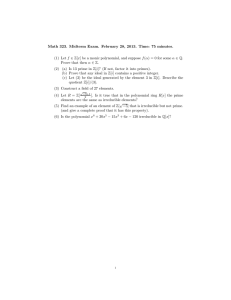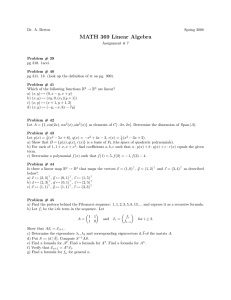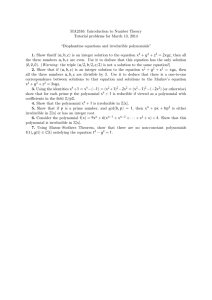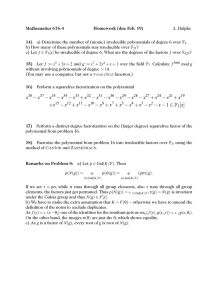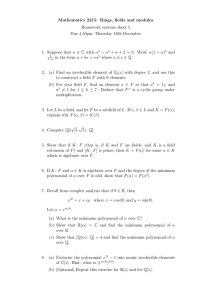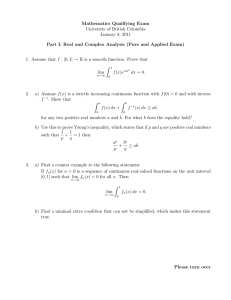eigenspaces Generalized Contents
advertisement
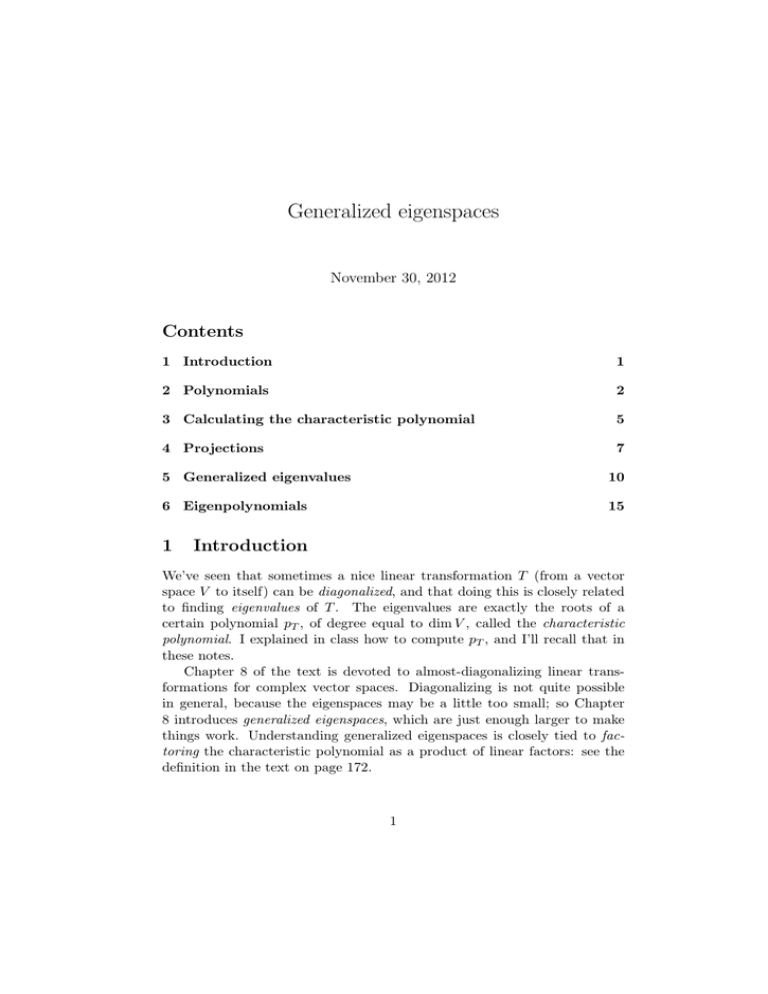
Generalized eigenspaces
November 30, 2012
Contents
1 Introduction
1
2 Polynomials
2
3 Calculating the characteristic polynomial
5
4 Projections
7
5 Generalized eigenvalues
10
6 Eigenpolynomials
15
1
Introduction
We’ve seen that sometimes a nice linear transformation T (from a vector
space V to itself) can be diagonalized, and that doing this is closely related
to finding eigenvalues of T . The eigenvalues are exactly the roots of a
certain polynomial pT , of degree equal to dim V , called the characteristic
polynomial. I explained in class how to compute pT , and I’ll recall that in
these notes.
Chapter 8 of the text is devoted to almost-diagonalizing linear trans­
formations for complex vector spaces. Diagonalizing is not quite possible
in general, because the eigenspaces may be a little too small; so Chapter
8 introduces generalized eigenspaces, which are just enough larger to make
things work. Understanding generalized eigenspaces is closely tied to fac­
toring the characteristic polynomial as a product of linear factors: see the
definition in the text on page 172.
1
When the field is not the complex numbers, polynomials need not have
roots, so they need not factor into linear factors. In these notes we’re going
to adapt Chapter 8 so that it works over any field. In particular, this will
more or less include what is done in Chapter 9 for the real numbers.
2
Polynomials
Recall from pages 10 and 22–23 of the text that P(F ) is the (F -vector
space) of all polynomials with coefficients in F . The degree of a nonzero
polynomial is the highest power of x appearing with nonzero coefficient;
the polynomial zero is defined to have degree −∞ (to make the formula
deg(pq) = deg(p) + deg(q) work when one of the factors is zero). We write
Pm (F ) = {am xm + · · · + a1 x + a0 | ai ∈ F }
(2.1)
for the m + 1-dimensional subspace of polynomials of degree less than or
equal to m. A polynomial is called monic if its leading coefficient is 1;
therefore
1,
x2 − 7x + 1/2,
x−π
are monic polynomials, but 2x + 1 is not monic.
Definition 2.2. A polynomial p(x) is called irreducible if
1. deg(p) > 0, and
2. p cannot be written as a product of two polynomials of positive degree.
If a is any nonzero scalar, then p is irreducible if and only if ap is irreducible;
so we can concentrate on monic polynomials in discussing irreducibility.
There is a really important analogy in mathematics between polynomials
and integers. In this analogy, irreducible polynomials correspond to (plus or
minus) prime numbers. Monic polynomials correspond to positive integers.
We can talk about the degree of a polynomial and about monic polyno­
mials without paying too much attention to the field F ; but the notion of
irreducible depends heavily on F . For example, the polynomial p(x) = x2 +1
is irreducible as a real polynomial; but as complex polynomial
p(x) = (x + i)(x − i),
so p is not irreducible. In the same way q(x) = x2 − 2 is irreducible in P(Q),
but in P(R)
√
√
q(x) = (x + 2)(x − 2).
2
Every degree one polynomial
(a, b ∈ F,
ax + b is irreducible,
a = 0)
(2.3)
for any field F .
For degree two polynomials, the story is
ax2 + bx + c irr ⇐⇒ no root in F ,
(a, b, c ∈ F,
a = 0)
(2.4)
In case 2 = 0 in F , we can apply the quadratic formula and deduce
ax2 + bx + c irr ⇐⇒ b2 − 4ac has no square root in F .
(2.5)
This statement covers the examples above: for x2 + 1 over R, b = 0 and
a = c = 1; b2 − 4ac = −4 has no square root in R, so x2 + 1 is irreducible. In
case F = F2 is the field with two elements, one can check that 0 and 1 are not
roots of p(x) = x2 + x + 1; so p is irreducible, even though b2 − 4ac = 1 = 12 .
(In fact p is the only irreducible polynomial of degree 2 in P(F2 ). Can you
see why?)
Proposition 2.6. Suppose F is a field. The following conditions are equiv­
alent:
1. every polynomial of positive degree in P(F ) has a root;
2. every nonzero polynomial in P(F ) is a product of linear factors:
p(x) = a
deg
ep
(x − λj )
(λj ∈ F, 0 = a ∈ F ).
j=1
3. the irreducible polynomials in P(F ) are those of degree one ( (2.3)).
If these equivalent conditions are satisfied, we say that F is algebraically
closed.
The fundamental theorem of algebra says that C is algebraically closed.
The factorization of arbitrary polynomials into linear factors is at the heart
of finding eigenvalues, and therefore of Chapter 8. Here is a substitute that
works in any field.
Proposition 2.7. Any monic polynomial p ∈ P(F ) can be written as a
product of powers of distinct monic irreducible polynomials {qi | 1 ≤ i ≤ r}:
p(x) =
r
e
qi (x)
mi
,
deg p =
i=1
r
r
i=1
3
mi deg qi .
Here mi and deg qi are positive integers, so r ≤ deg p. This factorization of
p is unique up to rearranging the factors. The irreducible qi that appear are
precisely the irreducible factors of p.
In the analogy between polynomials and integers, this proposition corre­
sponds to the fundamental theorem of arithmetic (which says that a positive
integer has a unique factorization as a finite product of prime powers).
If F is algebraically closed, then qi = x − λi , and the λi that appear
are precisely the roots of p. So this proposition is generalization of the
fundamental theorem of algebra that applies to any field.
We are going to need just one slightly exotic fact about polynomials and
factorization. It’s based on
Definition 2.8. We say that the nonzero polynomials p1 and p2 are rela­
tively prime if they have no common factor of positive degree; equivalently,
if there is no irreducible polynomial q that divides both p1 and p2 .
Example 2.9. The polynomials p1 and x − λ are relatively prime if and only
if λ is not a root of p1 ; that is, if and only if p1 (λ) 6= 0.
If p1 6= 0, then p1 and 1 are always relatively prime (because 1 has no
factors of positive degree).
g
gn
The polynomials m
i=1 (x − λi ) and
j=1 (x − µj ) are relatively prime if
and only if
{λi } ∩ {µj } = ∅;
that is, if and only if there are no roots in common.
Here is the exotic fact.
Proposition 2.10. Suppose p1 and p2 are relatively prime (nonzero) poly­
nomials. Then there are polynomials a1 and a2 with the property that
a1 p1 + a2 p2 = 1.
I won’t prove this fact; it’s stated in Artin’s algebra book [1] as Theorem
11.1.5 (page 390), for which the proof is similar to the one given for the
corresponding fact for integers (Proposition 2.2.6 on page 46). Here are
some examples meant to be supportive.
Example 2.11. Suppose p1 = x − λ and p2 = x − µ, with λ 6= µ. Then
a1 = 1/(µ − λ),
a2 = 1/(λ − µ).
It’s easy to check that this works, but maybe not so easy to see how to
generalize it.
4
So suppose
p1 (x) = (x − λ1 ) · · · (x − λr ),
p2 (x) = (x − µ1 ) · · · (x − µs ),
with λ1 , . . . , µs some r + s distinct elements of s. This time I’ll choose a1 to
be the (unique) polynomial of degree s − 1 with the property that
a1 (µj ) = p1 (µj )−1
(j = 1, . . . , s).
It’s not so difficult to write down such a polynomial a1 , using the ideas
appearing in the solutions to PS2. Similarly, you can find a2 of degree r − 1
with the property that
a2 (λi ) = p2 (λi )−1
(i = 1, . . . , r).
Then it follows that
(a1 p1 + a2 p2 )(λi ) = (a1 p1 + a2 p2 )(µj ) = 1
(i = 1, . . . , r, j = 1, . . . , s).
Therefore a1 p1 + a2 p2 − 1 is a polynomial of degree at most r + s − 1 having
r + s distinct zeros. It follows that a1 p1 + a2 p2 − 1 = 0, as we wished to
show.
3
Calculating the characteristic polynomial
The heart of the idea is this, which I proved in class in talking about eigen­
values.
Proposition 3.1. Suppose T ∈ L(V ), and 0 6= v0 ∈ V . Define
v j = T j v0 .
Let m be the smallest positive integer with the property that
vm ∈ span(v0 , . . . vm−1 ) =def U.
Then (v0 , . . . , vm−1 ) is linearly independent, so there is a unique expression
vm = −a0 v0 − · · · − am−1 vm−1 .
Define
p(x) = xm + am−1 xm−1 + · · · + a0 ,
a monic polynomial of degree m ≥ 1 in P(F ).
5
1. The m-dimensional subspace U of V is preserved by T : T U ⊂ U .
2. The linear transformation
p(T ) = T m + am−1 T m−1 + · · · + a0 I
acts by zero on U .
3. If z is a polynomial and z(T ) acts by zero on U , then z is divisible by
p.
4. The eigenvalues of T on U are precisely the roots of p.
5. If q is an irreducible polynomial and Null(q(T )) has a nonzero inter­
section with U , then q divides p.
In Definition 3.3 below, we will define the characteristic polynomial of
T on U to be the polynomial p described in (2). In order to relate this
information about U to the rest of V , we used the next proposition.
Proposition 3.2. Suppose V is a finite-dimensional vector space, T ∈
L(V ), and U ⊂ V is an invariant subspace: T U ⊂ U . Choose a basis
(e1 , . . . em ) for U , and extend it to a basis (e1 , . . . , em , em+1 , . . . en ) for V .
1. The matrix of T in the basis (e1 , . . . , en ) has the form
�
�
A B
.
0 C
Here A is the m × m matrix of T on the subspace U ; 0 represents the
(n−m)×m zero matrix; B is m×(n−m); and C is (n−m)×(n−m).
2. The set of eigenvalues of T is the union of the set of eigenvalues of A
and the set of eigenvalues of C.
3. Suppose q is an irreducible polynomial. Then
6 0 ⇐⇒ Null(q(A)) =
6 0 or Null(q(C)) =
6 0.
Null(q(T )) =
4. Suppose p1 and p2 are polynomials such that p1 (A) = 0 and p2 (C) = 0.
Then (p1 p2 )(T ) = 0.
6
Definition 3.3. The characteristic polynomial pT of T ∈ L(V ) is a monic
polynomial of degree equal to the dimension of V , defined by induction on
dim V as follows. If V = 0, then pT = 1. If V 6= 0, choose any nonzero
vector v0 ∈ V , and define U ⊂ V as in Proposition 3.1, and p as in (2) of
that Proposition. Then dim U = m > 0, and deg p = m; so n − m < n.
Write a matrix for T as in Proposition 3.2. Then C ∈ L(F n−m ). By
induction, the (monic) characteristic polynomial pC of C is already defined,
and deg pC = n − m. We can therefore define
pT = p · pC .
Clearly pT is monic, and
deg pT = deg p + deg pC = m + (n − m) = n.
By inductive hypothesis, pC (C) = 0, and by Proposition 3.1 p(A) = 0; so
by Proposition 3.2,
pT (T ) = 0.
What is not obvious from this definition is that the characteristic poly­
nomial is well-defined. The construction requires choosing a nonzero vector
v0 , and different choices lead to different U and different p. I will provide
some of the ingredients for proving that different choices lead to the same
pT , but I won’t prove this completely. For now I’ll just recall one thing I
did prove in class: for any choice of pT ,
{eigenvalues of T } = {roots of pT }.
(3.4)
The “base case” of this fact (the case of the subspace U constructed in
Proposition 3.1) is Proposition 3.1(4). The induction step is Proposition
3.2(2). Once we’ve defined “eigenpolynomials” in Section 6, the same proof
will show
{eigenpolynomials of T } = {irreducible factors of pT }.
4
(3.5)
Projections
The theorems we want about generalized eigenvalues and so on (Theorem
5.6, for example) provide direct sum decompositions of vector spaces. So it
is useful to say a few words about how to find direct sum decompositions.
This is essentially in the text on page 92.
7
Definition 4.1. Suppose V is a vector space. A projection on V is a lin­
ear map P ∈ L(V ) with the property that P 2 = P ; equivalently, a map
satisfying the polynomial x2 − x.
Proposition 4.2. Suppose V is a vector space. The following things are
in one-to-one correspondence:
1. projections P ∈ L(V );
2. pairs of linear transformations P and Q in L(V ) such that
P + Q = I,
P Q = 0;
(4.2a)
and
3. direct sum decompositions V = U ⊕ W .
The correspondence can be described as follows. Given a projection P as
in (1), define Q = I − P ; then P and Q satisfy (2).
Given P and Q as in (2), define
U = Range(P ) = Null(Q) = Null(I − P ) = Range(I − Q),
W = Range(Q) = Null(P ) = Null(I − Q) = Range(I − P ).
(4.2b)
Then V = U ⊕ W as in (3).
Given V = U ⊕ W as in (3), define
(u ∈ U, w ∈ W ).
P (u + w) = u
(4.2c)
Then P is a projection.
In terms of the eigenspaces of P , we have
U = V1,P ,
W = V0,P .
(4.2d)
W = V1,Q .
(4.2e)
In terms of the eigenspaces of Q,
U = V0,Q ,
The text writes PU,W for the projection corresponding to U ⊕ W (our
P ), and PW,U for the projection corresponding to W ⊕ U (our Q).
I have tried to state the proposition in such a way that it almost proves
itself. But here are some of the words.
8
Proof. Suppose P is a projection, so that P 2 = P , or equivalently
P − P 2 = 0,
P (I − P ) = 0.
(4.3)
In order to get the first requirement in (4.2a), we are forced to define Q =
I − P . Then the formulation P (I − P ) = 0 of the definition of projection
gives the second requirement in (4.2a).
Next, suppose P and Q satisfy (4.2a). First notice that
P = P I = P (P + Q) = P 2 + P Q = P 2 ,
so P is a projection. In the same way we see that Q2 = Q.
We want to get a direct sum decomposition of V ; so we define U = P V ,
W = QV . Then any v ∈ V may be written
v = Iv = (P + Q)v = P v + Qv = u + w,
with u = P v ∈ U and w = Qv ∈ W . So U + W = V . To see that the sum
is direct, suppose that U ∩ W contains the element P v1 = Qv2 . Applying
P to this equation and using P 2 = P and P Q = 0, we get P v1 = 0. This
proves that U ∩ W = 0, so the sum is direct.
If w = Qv belongs to W , then P w = P Qv = 0 by the assumption that
P Q = 0; so
W = Range(Q) ⊂ Null(P ).
Conversely, if x ∈ Null(P ), then x = Ix = (P + Q)x = Qx, so
Null(P ) ⊂ Range(Q) = W.
This proves the first two equalities for W in (4.2b). The last two are just
P = I − Q and Q = I − P . The equalities for U follow by interchanging the
roles of P and Q.
Finally, suppose V = U ⊕ W as in (3). The definition (4.2c) shows that
P 2 (u + w) = P (u) = u = P (u + w),
so P 2 = P as we wished to show. It is easy to see from the definitions
that if we follow these constructions around the circle (for example starting
with P , getting Q, then getting U and W and finally a new P i ) we always
return to where we began (that P i = P ). The remaining assertions about
eigenvalues are just reformulations of what we have already proved.
9
5
Generalized eigenvalues
This section summarizes Chapter 8 of the text. Remember from the text
(page 77) the description of the λ-eigenspace for any T ∈ L(V ):
Vλ =def {v ∈ V | T v = λv}
= Null(T − λ)
(5.1)
(q(x) = x − λ).
= Null(q(T ))
The multiplicity m(λ) of the eigenvalue λ is by definition the dimension of
the eigenspace Vλ .
The text does not use this definition of m(λ); instead the text de­
fines the multiplicity to be what I call generalized multiplicity (see
Definition 5.4 below). I think that the definition above is the one that most
people use.
Example 5.2. Here is one of the most important examples of eigenspaces.
Suppose
V = complex-valued functions on R,
D=
d
∈ L(V ).
dt
For any complex number λ, the λ-eigenspace of T is
Vλ = {f ∈ V |
df
= λf }.
dt
This is a first-order differential equation that you learned to solve in 18.03:
Vλ = {Aeλt | A ∈ C},
a one-dimensional space with basis vector eλt . Therefore the multiplicity of
the eigenvalue λ for D is m(λ) = 1.
To say that T is diagonalizable means that there is a basis of V consisting
of eigenvectors; equivalently, that
r
V =
Vλ
(T diagonalizable).
λ∈F
Even for C, not all operators are diagonalizable.
10
Example 5.3. Suppose V = C2 , and
�
�
1 1
T =
.
0 1
Because T is upper triangular, its eigenvalues are the diagonal entries; that
is, the only eigenvalue is 1. It’s easy to calculate the eigenspace:
� �
� �
0 1
x
V1 = Null(T − 1 · I) = Null
=
|x∈C .
0 0
0
So the only eigenspace is one-dimensional, so C2 cannot be the direct sum
of the eigenspaces. We are missing (from the eigenspace) the vectors whose
second coordinate is not zero. These are not in the null space of T − 1 · I:
�
�
�
�
�
�
� �
x
0 1
x
y
(T − I) ·
=
·
=
.
y
0 0
y
0
This is not zero (if y is not zero), but now it is in the null space of T − 1 · I.
Therefore
� �
� � � �
x
y
0
2
= (T − I) ·
=
.
(T − I) ·
y
0
0
To summarize, only the line through the first basis vector is in the 1­
eigenspace (the null space of T − 1 · I), but all of C2 is in the null space of
(T − 1 · I)2 .
Because eigenspaces are not big enough to decompose V , we need a good
way to enlarge them. The example suggests
Definition 5.4. Suppose T ∈ L(V ). The λ-generalized eigenspace of T is
V[λ] =def {v ∈ V | (T − λI)m v = 0 (some m > 0).} ⊂ V.
Clearly
Vλ ⊂ V[λ] ;
because if T v = λv, then we can take m = 1 in the definition of V[λ] .
The generalized multiplicity M (λ) of the eigenvalue λ is by definition the
dimension of the generalized eigenspace V[λ] .
The text never introduces a notation for generalized eigenspaces, and
the notation V[λ] used here is not standard. (So you always need to explain
it if you use it.)
11
Example 5.5. We return to the example of
V = complex-valued functions on R,
D=
d
∈ L(V ).
dt
You saw generalized eigenspaces in 18.03 as well; they appear when you try
to solve higher order differential equations like
f ii − 2f i + f = 0,
which can be written as
(D − I)2 f = 0.
One solution is et ; and another is tet . The reason is
D(tet ) = (Dt)et + t(Det ) = et + tet ,
so
(D − I)(tet ) = et ∈ Null(D − I).
In this way you learned (in 18.03!) that the λ generalized eigenspace of D
is
V[λ] = {p(t)eλt | p ∈ P(C)}.
This generalized eigenspace is infinite-dimensional (since the space of all
polynomials is infinite-dimensional) so the generalized multiplicity M (λ) is
infinite.
The main theorem of Chapter 8 is
Theorem 5.6 (text, Theorem 8.23). Suppose V is a finite-dimensional com­
plex vector space, T ∈ L(V ), and λ1 , . . . , λr are all the distinct eigenvalues
of T . Then
1. Each generalized eigenspace V[λi ] is preserved by T .
2. The space V is the direct sum of the generalized eigenspaces:
V =
r
r
V[λi ] .
i=1
3. The dimension of V is equal to the sum of the generalized multiplicities
of all the eigenvalues:
dim V =
r
r
i=1
12
M (λi ).
Proof. Part (1) of the theorem is almost obvious. I will prove (2) by induc­
tion on r. Write pT for the characteristic polynomial of T (Definition 3.3).
Because C is algebraically closed, pT is a product of linear factors. Because
the roots of pT are precisely the eigenvalues of T , these linear factors must
each be x − λi for some i. Therefore there are positive integers mi so that
pT (x) = (x − λ1 )m1 · · · (x − λr )mr
(5.7a)
If r = 0, then pT = 1, V = 0, T = 0, and there is nothing to prove: the
zero vector space is an empty direct sum. So suppose r ≥ 1, so that λ1 is
an eigenvector, and
0 6= Vλ1 ⊂ V[λ1 ] .
We factor the polynomial pT as
pT = p1 p2 ,
p1 = (x − λ1 )m1 ,
p2 = (x − λ2 )m2 · · · (x − λr )mr
(5.7b)
The only irreducible factor of p1 is x − λ1 , and that is not a factor of p2 ; so
p1 and p2 are relatively prime (2.8). According to Proposition 2.10, we can
find polynomials a1 and a2 so that
a1 p1 + a2 p2 = 1.
(5.7c)
We now define linear transformations P and Q on V by
P = a2 (T )p2 (T ),
Q = a1 (T )p1 (T ).
(5.7d)
Applying the identity (5.7c) to T gives
P + Q = a2 (T )p2 (T ) + a1 (T )p1 (T ) = 1(T ) = I.
(5.7e)
Similarly, the identity pT (T ) = 0 (Definition 3.3), together with the factor­
ization (5.7b), gives
P Q = a2 (T )p2 (T )a1 (T )p1 (T ) = a1 (T )a2 (T )pT (T ) = 0.
(5.7f)
So P and Q satisfy the conditions of Proposition 4.2(2), so we get a direct
sum decomposition
V = U ⊕ W.
(5.7g)
We find
U = Range(P )
(Proposition 4.2)
= Range(p2 (T )a2 (T )) (definition of P )
⊂ Null(p1 (T ))
(since p1 (T )p2 (T ) = pT (T ) = 0)
⊂ Null(a1 (T )p1 (T ))
= Null(Q) = U
(Proposition 4.2)
13
(5.7h)
So the inclusions are equalities, and (by the middle formula)
U = Null((T − λ1 )m1 ) = V[λ1 ] .
(5.7i)
W = Null(p2 (T )),
(5.7j)
Similarly we find
so W is a T -invariant subspace on which the eigenvalues of T are the r − 1
scalars λ2 , . . . , λr . By inductive hypothesis,
r
r
W =
W[λi ] ,
(5.7k)
i=2
and therefore
V = U ⊕ W = V[λ1 ] ⊕
r
r
W[λi ] .
(5.7l)
i=2
as we wished to show.
Statement (3) is just the fact the dimension of a direct sum is the sum
of the dimensions of the summands.
In class I looked in some detail at
Example 5.8.
V = R3 ,
⎛
⎞
1 2
3
1 ⎠.
T = ⎝0 1
0 −1 −1
I defined
�
C=
�
1
1
,
−1 −1
the block in the lower right of T . The characteristic polynomial of the
1 × 1 matrix (1) is x − 1, so according to Proposition 3.2, the characteristic
polynomial of T is
pT = (x − 1)pC .
We calculated pC = x2 (which is an excellent exercise using Proposition 3.1).
So
pT = (x − 1)x2 ,
and the two eigenvalues are 1 and 0. We calculated
⎛ ⎞
⎛ ⎞
1
1
⎝
⎠
⎝
V0 = R · 1 ⎠ .
V1 = R · 0 ,
0
−1
14
The eigenspaces are not quite big enough to span R3 . The generalized
eigenspace for 0 has a chance to be bigger, because 0 is a double root of
pT . In fact
V[0] = Null(T 2 )
⎛
⎞
1 1 2
= Null⎝0 0 0⎠
0 0 0
⎛⎛ ⎞ ⎛ ⎞⎞
1
3
⎝⎝
⎠
⎝
1 , −1⎠⎠ .
= span
−1
−1
6
Eigenpolynomials
In this section (corresponding to Chapter 9 of the text) we look for replace­
ments for eigenvalues to use over fields other than C. Recall from (5.1) the
description of an eigenspace
(q(x) = x − λ).
Vλ = Null(q(T ))
Because x − λ is an irreducible polynomial, this description suggests a gen­
eralization.
Definition 6.1. Suppose q is a monic irreducible polynomial in P(F ), and
T ∈ L(V ). The q-eigenspace of T is
Vq =def Null(q(T )) = {v ∈ V | q(T )v = 0} ⊂ V.
If Vq 6= 0, we say that q is an eigenpolynomial for T . The multiplicity of the
eigenpolynomial q is by definition
m(q) =
dim Vq
.
deg q
From its definition the multiplicity looks like a rational number, but we’ll
see in Proposition 6.2 that it’s actually an integer.
Comparing (5.1) to Definition 6.1, we see that λ is an eigenvalue of T if
and only if x − λ is an eigenpolynomial of T .
I don’t know a good and widely used name for what I called “eigenpoly­
nomial.” This definition more or less appears in the text on page 205 for the
case F = R, when the only irreducible polynomials are x − λ (with λ ∈ R)
and x2 + αx + β (with α2 − 4β < 0).
15
Proposition 6.2. Suppose
q(x) = xd + ad−1 xd−1 + · · · + a0
is a monic irreducible polynomial, and T ∈ L(V ).
1. The subspace Vq is a T -invariant subspace of V .
2. The subspace Vq is not zero if and only if q divides the characteristic
polynomial of T .
3. Suppose v0 is any nonzero vector in Vq . Define vi = T i v0 . Then the
list (v0 , . . . vd−1 ) is linearly independent, and
vd = −ad−1 vd−1 − · · · − a0 v0 .
The subspace span(v0 , . . . , vd−1 ) is T -invariant, and the matrix of T
on this subspace and in this basis is the d × d matrix
⎛
⎞
0 0 · · · 0 −a0
⎜1 0 · · · 0 −a1 ⎟
⎜
⎟
⎜
⎟
Aq =def ⎜0 1 · · · 0 −a2 ⎟ .
⎜
⎟
.
..
⎝
⎠
. ..
0 0 ···
1 −ad−1
4. There is a basis of Vq in which the matrix of T is block diagonal, with
every block equal to Aq .
5. The characteristic polynomial of T acting on Vq is a power of q.
6. The dimension of Vq is a multiple of the degree d of q; so the multi­
plicity m(q) is an integer.
The general formula for the matrix Aq looks a bit peculiar, but sometimes
it’s quite nice. For example
�
�
0 −1
Ax2 +1 =
;
(6.3)
Ax−λ = (λ),
1 0
the second formula applies whenever x2 + 1 is irreducible, for example for
the real numbers. The proposition is also true if Aq is replaced by any other
matrix Aiq having characteristic polynomial q. Suppose for example that
F = R, and that q is the real polynomial having roots
re±iθ = r cos θ ± ir sin θ = a ± ib,
16
(6.4a)
with r > 0 and 0 < θ < π (equivalently, b > 0). Then
q(x) = x2 − 2r cos θ + r2 = x2 − 2ax + a2 + b2 ,
(6.4b)
Consequently
Aiq
�
� �
�
0 −a2 − b2
0
−r2
=
=
.
1 2r cos θ
1
2a
(6.4c)
This formula is not so nicely related to what we understand about complex
numbers. So it is often convenient to use instead
�
� �
�
r cos θ −r sin θ
a −b
Aq =
=
(b > 0),
(6.4d)
r sin θ r cos θ
b a
which also has characteristic polynomial q. The matrices Aiq appear in the
text in Theorem 7.25 (concerning normal linear transformations on real
inner product spaces). But they don’t need to have anything to do with
inner products; they could have been introduced in Theorem 5.24.
According to Proposition 6.2, these “eigenspaces” for irreducible poly­
nomials behave very much like eigenspaces for eigenvalues. Using exactly
the same proof as for eigenvalues, one can deduce
Corollary 6.5. Suppose V is a finite-dimensional vector space, and T ∈
L(V ). Then there is a basis of T in which the matrix of T is block-upper­
triangular, and every diagonal block is one of the matrices Aq , with q an
irreducible factor of the characteristic polynomial of T .
To have a complete theory, we just need to add the word “generalized.”
Definition 6.6. Suppose q is a monic irreducible polynomial, and T ∈
L(V ). The q-generalized eigenspace of T is
V[q] =def {v ∈ V | q(T )m v = 0 (some m > 0).} ⊂ V.
Clearly
Vq ⊂ V[q] ;
The generalized multiplicity M (q) of the eigenpolynomial q is
M (q) =def
17
dim V[q]
.
deg q
Theorem 6.7 (text, Theorem 8.23). Suppose V is a finite-dimensional vec­
tor space, T ∈ L(V ), pT is the characteristic polynomial of T (a monic
polynomial of degree equal to the dimension of V . Factor pT into distinct
irreducible factors in accordance with Proposition 2.7:
pT (x) =
r
e
qi (x)mi .
i=1
1. Each generalized eigenspace V[q] is preserved by T .
2. The space V is the direct sum of the generalized eigenspaces:
V =
r
r
V[qi ] .
i=1
3. The dimension of V is
dim V =
r
r
M (qi ) deg qi .
i=1
The proof is almost word-for-word the same as the proof of Theorem 5.6;
it’s a good exercise to try to write down the proof without consulting that
one.
References
[1] Michael Artin, Algebra, Prentice Hall Inc., Englewood Cliffs, NJ, 1991.
18
MIT OpenCourseWare
http://ocw.mit.edu
18.700 Linear Algebra
Fall 2013
For information about citing these materials or our Terms of Use, visit: http://ocw.mit.edu/terms.

